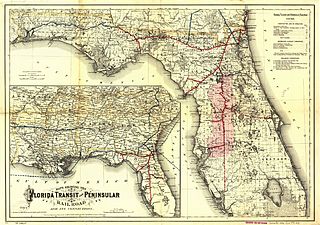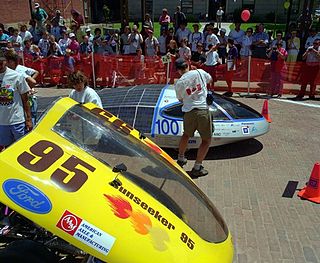Related Research Articles

Dixie Highway was a United States auto trail first planned in 1914 to connect the Midwest with the South. It was part of a system and was expanded from an earlier Miami to Montreal highway. The final system is better understood as a network of connected paved roads, rather than one single highway. It was constructed and expanded from 1915 to 1929.

The Southeastern United States, also referred to as the American Southeast, the Southeast, or simply the South, is a geographical region of the United States. It is located broadly on the eastern portion of the Southern United States and the southern portion of the Eastern United States. It comprises at least a core of states on the lower East Coast of the United States and eastern Gulf Coast. Expansively, it reaches as far north as West Virginia and Maryland, which borders the Ohio River and Mason–Dixon line, and stretches as far west as Arkansas and Louisiana. There is no official U.S. government definition of the region, though various agencies and departments use different definitions.

The Southeast Corridor (SEC) is a proposed passenger rail transportation project in the Mid-Atlantic and Southeastern United States to extend high-speed passenger rail services from Washington, D.C. south through Richmond, Petersburg with a spur to Norfolk in Virginia through Raleigh, Durham, Greensboro and south to Charlotte in North Carolina and connect with the existing high-speed rail corridor from D.C. to Boston, Massachusetts known as the Northeast Corridor. Since first established in 1992, the U.S. Department of Transportation (USDOT) has extended the corridor to Atlanta, Georgia and Macon, Georgia; Greenville, South Carolina; Columbia, South Carolina; Jacksonville, Florida; and Birmingham, Alabama.

John William Heisman was a player and coach of American football, baseball, and basketball, as well as a sportswriter and actor. He served as the head football coach at Oberlin College, Buchtel College, Auburn University, Clemson University, Georgia Tech, the University of Pennsylvania, Washington & Jefferson College, and Rice University, compiling a career college football record of 186–70–18.

The Florida Central and Peninsular Railroad was the final name of a system of railroads throughout Florida, becoming part of the Seaboard Air Line Railway in 1900. The system, including some of the first railroads in Florida, stretched from Jacksonville west through Tallahassee and south to Tampa. Much of the FC&P network is still in service under the ownership of CSX Transportation.

The American Solar Challenge (ASC), previously known as the North American Solar Challenge and Sunrayce, is a solar car race across the United States. In the race, teams from colleges and universities throughout North America design, build, test, and race solar-powered vehicles in a long distance road rally-style event. ASC is a test of teamwork, engineering skill, and endurance that stretches across thousands of miles of public roads.

The University of Minnesota Solar Vehicle Project, or UMNSVP, is a team of undergraduate students from the University of Minnesota that designs and constructs solar-powered cars. In its 31 years, it has established itself as one of the world's top solar racing teams, and the top Cruiser/Multi-Occupant Vehicle team in the Western Hemisphere, with top-two finishes in eighteen of thirty-four events entered.
PrISUm Solar Car is the multidisciplinary student-run solar car racing team from Iowa State University that designs and builds solar powered vehicles to compete in the American Solar Challenge (ASC). The club was founded in 1989 by a group of engineering honor students from Tau Beta Pi and was simply known as the ISU Solar Car Project. In 1990, the team adopted the name of its first car, PrISUm.
Solar car racing refers to competitive races of electric vehicles which are powered by solar energy obtained from solar panels on the surface of the car. The first solar car race was the Tour de Sol in 1985 which led to several similar races in Europe, US and Australia. Such challenges are often entered by universities to develop their students' engineering and technological skills, but many business corporations have entered competitions in the past. A small number of high school teams participate in solar car races designed exclusively for high school students.
The Cal State LA Solar Car Team was a group of engineering students at California State University, Los Angeles that developed the Solar Eagle series of solar cars that competed in solar car races in the United States and Australia.

The Midnight Sun Solar Rayce Car Team is a Canadian solar car race team affiliated with the University of Waterloo of Waterloo, Ontario. Founded in 1988, the Midnight Sun team is a student-run organization which designs and builds a solar vehicle every two to three years to compete in two solar challenges; the World Solar Challenge, held in Australia, and the American Solar Challenge, held in the United States.

The Sunseeker Solar Car Project, Sunseeker for short, is Western Michigan University's solar car team. Each vehicle is designed, built, maintained, and raced by students. Sunseeker has competed in all of the American Solar Challenge events, going back to 1990.
Sunrayce 93 was a solar car race across the United States, traveling from Arlington, Texas, to Minneapolis, Minnesota. It took place June 20–26, 1993 and featured 34 university teams. In the race, teams from colleges and universities throughout North America designed, built, tested, and raced solar-powered vehicles in a long distance road rally-style event. The first place car was Maize & Blue from the University of Michigan, winning their second championship.
In July 1990, 32 teams of some of North America's brightest college students took to the road in solar-powered vehicles they had built during the previous year and a half. The GM Sunrayce USA route covered more than 1,800 miles, from Florida to Michigan. Three of the top finishers won a trip to Australia in November to compete in the 1990 World Solar Challenge.
The Breakfast Club is an American syndicated radio show based in New York City. It is hosted by DJ Envy, Charlamagne tha God and rotating guest hosts and celebrities. The Breakfast Club's flagship station is WWPR-FM Power 105.1 and it currently airs in over 90 radio markets around the U.S., including Chicago, Houston, Atlanta and Miami.
Sunrayce 95 was an intercollegiate solar car race on June 20–29, 1995. The event was won by the Massachusetts Institute of Technology, with the University of Minnesota finishing less than 20 minutes behind them. It was the 3rd American national championship solar car race held.
Sunrayce 97 was an intercollegiate solar car race on June 19–28, 1997. The event was won by Cal State LA, with the Massachusetts Institute of Technology finishing less than 20 minutes behind them. It was the 4th American national championship solar car race held.
The 1983 National Collegiate women's slow-pitch softball championship was held in Graham, North Carolina, near Raleigh, on May 5–7. This was the first year after the demise of the AIAW, which had conducted the previous two national title tournaments in 1981 and 1982. The Amateur Softball Association stepped in to fill the void by organizing the 1983 tournament and another in 1984. Those four years were the only time that major college slow-pitch teams competed for national collegiate titles, although small NAIA schools and junior colleges also conducted their own slow-pitch championships into the 1990s. The AIAW had lost its struggle with the NCAA, which vanquished the women's collegiate athletic organization after a year of dual crowning of champions in women's sports. Although the NCAA began sponsoring fast-pitch softball in 1982, it opted not to organize slow-pitch.

Gary Michael Hilton, known as the National Forest Serial Killer, is an American serial killer responsible for four known homicides between 2007 and 2008 committed in three states, all of which occurred within the premises of national forests. Sentenced to death in Florida and to life imprisonment in Georgia and North Carolina, Hilton remains a suspect in several other killings, including that of Judy Smith.